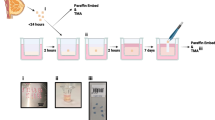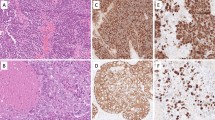Malignant cell lines related to mouse lung alveologenic carcinoma have been established from urethane-induced tumors and after in vitro spontaneous transformation of preneoplastic cell lines. Both the chemically and spontaneously transformed cell lines formed invasive, poorly differentiated carcinomas with secondary lung deposits when implanted subcutaneously in immune-suppressed mice. They differed from the related preneoplastic cell line in coordinately exhibiting anchorage-independent growth, reduced epidermal growth factor receptor activity and absence of pericellular fibronectin. These data suggest that similar molecular events may occur in type 2 pneumocyte-related cells in order to generate mouse lung alveologenic adenomas and carcinomas by both spontaneous and chemical carcinogen induction mechanisms. A reduced level of pericellular fibronectin was also demonstrated in an in situ compressive urethane-induced mouse lung adenoma. Loss of pericellular fibronectin may therefore be an early and persistent phenotypic alteration during transformation to the alveologenic adenoma and carcinoma.
Similar content being viewed by others
Abbreviations
- EGF:
-
epidermal growth factor
- TGF:
-
transforming growth factor
References
AHARONOV, A., PRUSS, R.M. and HERSCHMAN, H.R. (1978). EGF: relationship between receptor regulations and mitogens in 3T3 cells. J. Biol. Chem. 253:3970–3977.
BARKLA, D.H. and TUTTON, J.M. (1981). Influence of histamine and serotonin antagonists on the growth of xenografted human colorectal tumors. J. Natl. Cancer Inst. 67:1207–1212.
BEN-ZE'EV, A. (1985). The cytoskeleton in cancer cells. Biochim. Biophys. Acta 780:197–212.
BLOOM, J.L. and FALCONER, D.S. (1964). A gene with major effect on susceptibility to induced lung tumours in mice. J. Natl. Cancer Inst. 33:607–618.
BOREK, C. (1983). Epithelial in vitro cell systems in carcinogenesis studies. In: Cellular Systems for Toxicity Testing (Eds. G. M. Williams, V.C. Dunkel and V.A. Ray). Ann. N.Y. Acad. Sci. 407:284–290.
CARPENTER, G. and COHEN, S. (1976). 125I-labeled human epidermal growth factor. J. Cell Biol. 71:159–171.
CHANDLER, L.P., CHANDLER, C.E., HOSANG, M. and SHOOTER, E.M. (1985). A monoclonal antibody which inhibits EGF binding has opposite effects on the biological action of EGF in different cells. J. Biol. Chem. 260:3360–3367.
CHEN, T.R. (1977). In situ detection of mycoplasma contamination of cell cultures by fluorescent Hoechst 33258 stain. 104:255–262.
CHEN, W-I., WANG, J., HASEGAWA, T., YAMADA, S.S. and YAMADA, K.M. (1986). Regulation of fibronectin receptor distribution by transformation, exogenous fibronectin and synthetic peptides. J. Cell Biol. 103:1649–1661.
DiPAOLO, J.A. (1965). Chromosome patterns in mouse lung tumours. J. Natl. Cancer Inst. 34:337–343.
DOWNWARD, J., YARDEN, Y., MAYES, E., SCRACE, G., TOTTY, N., STALEWELL, P., ULLRICH, A., SCHLESSINGER, J. and WATERFIELD, M.D. (1984). Close similarity of EGF receptor and v-erb-B oncogene protein sequences. Nature 307:521–527.
EVANS, M.J., CABRAL, L.J., STEPHENS, R.J. and FREEMAN, G. (1973). Renewal of alveolar epithelium in the rat following exposure to NO2. Amer. J. Pathol. 70:175–198.
FANGER, B.D., VICEPS-MADERE, D. and CIDLOWSKI, J.A. (1984). Regulation of high and low affinity EGF receptors by glucocorticoids. Arch. Biochem. Biophys. 235:141–149.
FRANKS, L.M. and WIGLEY, C.B. (1979). Neoplastic transformation in differentiated epithelial cell systems in vitro. Academic Press, London.
HARRIS, C.C. (1987). Human tissues and cells in carcinogenesis research. Cancer Res. 47:1–10.
KAUFMANN, S.L., ALEXANDER, L. and Sass, L. (1979). Histologic and ultrastructural features of the clara cell adenoma of the mouse lung. Lab. Investigation 40:708–716.
KNAUER, D.J., WILEY, H.S. and CUNNINGHAM, D.D. (1984). Relationship between EGF receptor occupancy and mitogenic response. Quantitative analysis using a steady state model system. J. Biol. Chem. 259:5623–5631.
LWEBUGA-MUKASA, J.S., THULIN, G., MADRI, J.A., BARRETT, C. and WARSHAW, J.B. (1984). An acellular human amnionic membrane model for in vitro culture of type II pneumocytes: the role of the basement membrane in cell morphology and function. J. Cellular Phys. 121:215–225.
LWEBUGA-MUKASA, J.S., INGBAR, D.H. and MADRI, J.A. (1986). Repopulation of a human alveolar matrix by adult rat type II pneumocytes in vitro. Exp. Cell Res. 162:423–435.
MALKINSON, A.M., NESBITT, M.N. and SKAMENE, E. (1985). Susceptibility to urethane-induced pulmonary adenomas. J. Natl. Cancer Inst. 75:971–974.
RUOSLAHTI, E. (1984). Fibronectin in cell adhesion and invasion. Cancer Metast. Reviews 3:43–51.
SAITO, K., LWEBUGA-MUKASA, J., BARRETT, C., LIGHT, D. and WARSHAW, J.B. (1985). Characteristics of primary isolates of alveolar type II cells from neonatal rats. Exp. Lung Res. 8:213–225.
SAVAGE, C.R. and COHEN, S. (1972). Epidermal growth factor and a new derivative. J. Biol. Chem. 247:7609–7611.
SHIMKIN, M.B. and STONER, G.D. (1975). Lung tumors in mice: Application to carcinogenesis bioassay. Adv. Cancer Res. 21:1–58.
SMITH, G.J. and BENTEL, J. (1987). Malignant epithelial cell strains cultured from BALB/c mouse lung adenoma. Cell Biol. Int. Reports 11:111–118.
SMITH, G.J. and LYKKE, A.W.J. (1985). Characterization of a neoplastic epithelial cell strain derived by dexamethasone treatment of cultured normal mouse type 2 pneumocytes. J. Pathology 147:165–172.
SMITH, G.J. and STEWART, B. (1982). In vitro epithelial cell differentiation and neoplasia. Australian Cancer Soc., Sydney, Australia.
SMITH, G.J., LeMESURIER, S.M., DeMONTFORT, M.L. and LYKKE, A.W.J. (1984a). Establishment of epithelial cells from normal adult mouse lung resembling a urethaneinduced lung adenoma cell strain and a metastasizing mouse lung carcinoma cell line. Cell Biol. Int. Reports 8:161–169.
SMITH, G.J., LeMESURIER, S.M., DeMONTFORT, M.L. and LYKKE, A.W.J. (1984b). Development and characterization of type 2 pneumocyte-related cell lines from normal adult mouse lung. Pathology 16:401–405.
SMITH, G.J., KUMAR, R.K., HRISTOFORIDIS, C.P. and LYKKE, A.W.J. (1985). Expression of a type 2 pneumocyte-specific antigen by a cell strain from normal adult mouse lung. Cell Biol. Int. Reports 9:1115–1122.
SMITH, G.J., BENNETT, F.A., STEELE, J.G. and BENTEL, J.M. (1986). Onset of neoplastic phenotype in an epithelial cell strain from adult BALB/c mouse lung alveolus. J. Natl. Cancer Inst. 76:73–79.
STEELE, J.G., ROWLATT, C.R., SANDALL, J. and FRANKS, L.M. (1983). Cell surface properties of high and low metastatic cell lines from a spontaneous mouse lung carcinoma. Int. J. Cancer 32:769–779.
STEELE, J.G., DALTON, B.A., HOFFMAN, H., UNDERWOOD, P.A. and RATHJEN, D. (1985). Monoclonal antibodies to nerve growth factor from bovine seminal plasma. Mol. Immunol. 22:1061–1072.
STONER, G.D., KIKKAWA, Y., KNIAZEFF, A.J., MIYAI, K. and WAGNER, R.M. (1975). Clonal isolation of epithelial cells from mouse lung adenoma. Cancer Res. 35:2177–2185.
WARD, J.M., SINGH, G., KATYAL, S.L., ANDERSON, L.M. and KOVATCH, R.M. (1985). Immunocytochemical localization of the surfactant apoprotein and a clara cell antigen. Am J. Pathol. 118:493–499.
WIDDICOMBE, J. G. and PACK, R.J. (1982). The clara cell. Eur. J. Respir. Dis. 63:202–220.
WILLIAMS, M.C., SCHENK, D., LEWICKI, J., BENSON, B.J., HAWGOOD, S. and WALKER, S.R. (1985). Monoclonal antibodies against surfactant apoproteins label both alveolar type 2 cells and nonciliated bronchiolar cells in dog lung. J. Cell Biol. 101:444a.
Author information
Authors and Affiliations
Rights and permissions
About this article
Cite this article
Smith, G.J., Steele, J.G., Bentel, J.M. et al. A cell culture model of chemically and spontaneously derived mouse lung alveologenic carcinoma. Cell Biol Toxicol 4, 333–348 (1988). https://doi.org/10.1007/BF00058741
Received:
Accepted:
Issue Date:
DOI: https://doi.org/10.1007/BF00058741




